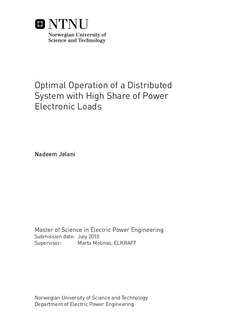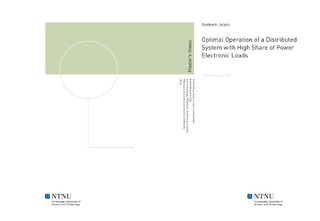| dc.contributor.advisor | Molinas, Marta | nb_NO |
| dc.contributor.author | Jelani, Nadeem | nb_NO |
| dc.date.accessioned | 2014-12-19T13:51:30Z | |
| dc.date.available | 2014-12-19T13:51:30Z | |
| dc.date.created | 2010-09-04 | nb_NO |
| dc.date.issued | 2010 | nb_NO |
| dc.identifier | 348969 | nb_NO |
| dc.identifier | ntnudaim:5692 | nb_NO |
| dc.identifier.uri | http://hdl.handle.net/11250/256672 | |
| dc.description.abstract | The tendency of connecting the loads to the three phase AC system through power electronic interfaces is increasing with time. These interfaces greatly affect the performance of the power system when properly operated. The injection of reactive power by these interfaces provides the possibility to support the voltage, increase the stability margins and decrease the power losses in the power system. The power electronic loads when tightly regulated consume constant power from the grid and therefore exhibit negative resistance instability behavior. A fast control system with high stability margins is desirable for the converters. This thesis deals with the control of power electronic loads and the stability of the AC distribution system. One of the objectives of the work is to understand the basic control structure of the converters and establish the tuning rules for the PI regulators of the converter controllers. A basic power electronic converter is considered and vector control method is implemented. A mathematical model of the control system for the converter is described and transfer functions are analyzed in frequency domain for different values of grid voltage. The simulations in time domain are performed in PSCAD/EMTDC software. The simulation results validate the results from the frequency domain analysis. The simulation analysis also shows that the stability of the converter in generation mode is higher as compared to when it acts as a load. A larger model of AC distribution system with different shares of loads is investigated for the transient stability. It has been observed through simulations that the injection of reactive power during contingency greatly improve the stability limits of the system. However this increase in the stability margins comes at the cost of an increase in converter current rating. A comparison between the distributed injection by parallel converter and centralized injection through STATCOM confirms the advantages of the distributed injection. | nb_NO |
| dc.language | eng | nb_NO |
| dc.publisher | Institutt for elkraftteknikk | nb_NO |
| dc.subject | ntnudaim | no_NO |
| dc.subject | MSELPOWER Master of Science in Electric Power Engineering | no_NO |
| dc.subject | Elektrisk Energiteknikk | no_NO |
| dc.title | Optimal Operation of a Distributed System with High Share of Power Electronic Loads | nb_NO |
| dc.type | Master thesis | nb_NO |
| dc.source.pagenumber | 136 | nb_NO |
| dc.contributor.department | Norges teknisk-naturvitenskapelige universitet, Fakultet for informasjonsteknologi, matematikk og elektroteknikk, Institutt for elkraftteknikk | nb_NO |

